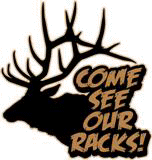|









| |
About the Elk Farm....
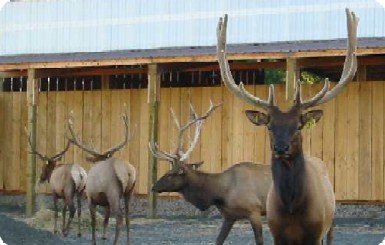 |
Established in April, 2005, Rosse Posse Acres Elk Farm is a licensed and
insured elk farm operating in beautiful
Molalla, Oregon. We provide
quality, farm-raised wapiti (elk meat) for sale along with ancillary elk related
products in our gift shop. We sell wapiti by the half
or whole elk.
Our elk are fed the best quality hay.
The meat is very mild in flavor,
naturally low in cholesterol and fat, and very
lean. If you've never tried wapiti before, you are definitely missing out
on one of the best cuts of meat you will ever taste.
|
Here are some of the sights and sounds of our
elk farm:
(Note: All sound files were captured on my Nokia cell phone,
so these are not professional quality sound files)
Elk Calendar:
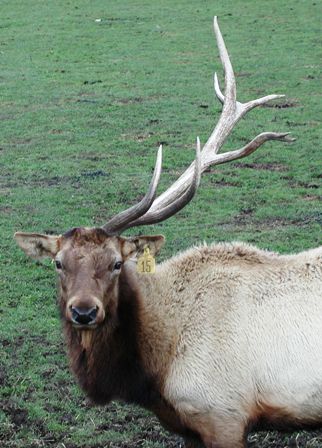 |
December - March: There isn't a whole lot going on at the farm
during the winter. Winters in the Willamette valley tend to be
temperate, but very wet. During the winter, the calves have been weaned
from their mothers, and everybody is getting full rations of Alfalfa hay and
supplements to carry them through so they are all set for the
spring.
Check out "Big Boy" after shedding one of his antlers. Picture
taken March, 2007.
|
| March - April: This is the time when the bulls begin growing their
"velvet". Elk Velvet Antler is one of the fastest growing animal parts
known to man. It can grow at a rate of an inch or more every day!
The velvet begins growing in March and reaches full growth by early August at
which time it begins to calcify into hard antler.
This is also the time when the bulls are their most docile, which means a great time to give the entire herd
their yearly inoculations and parasite control. This is done in the
handling facility by running the herd, one by one, through the squeeze chute.
The chute has an electronic scale so we know exactly how much each animal
weighs; thus we can administer accurate dosages for optimal effect.
After the animal is weighed, we put a squeeze on them and then give them their
shots.
|
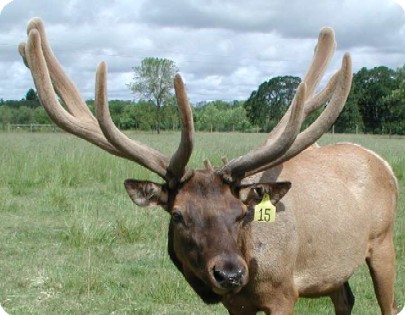 |
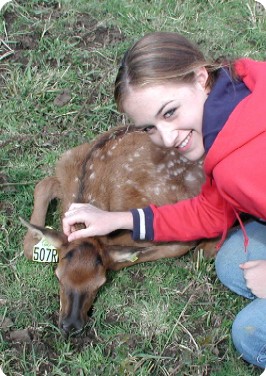 |
May - June: Calving! What a fun time to be an elk
farmer! The calves start dropping towards the end of May and keep coming
through the entire month of June. Sometimes we even get a few late ones
in July. When the calves are born, the cow/calf pair are not bothered for the first 24 hours
of life so that the mother can clean up the calf and bond and the calf can get
that vital first nursing accomplished. But, the calf does need to be
weighed, sexed, tagged, and given a dose of Selenium. So the day after birth
finds us out in the field searching for the well hidden little beauties.
It is amazing just how well these little guys can hide! Once found, they
remain absolutely motionless as we go about our duties. Of course,
momma cow is not happy at all with us messing with her precious, which is why
before we go out looking for the calf we dupe momma into coming up front for
some hay or oats while we slip in behind her and close the gate to the
pasture!
Pop Quiz: How can you tell the difference between a male and female elk?
Answer: Males are tagged in the left ear and females are tagged in the right ear.
Extra Credit Question: Why are females tagged in the right ear?
Answer: Because girls are always right!
|
| August - September: Hard Antler! The bulls begin
forming hard antler as their velvet reaches full growth in early August and
the antler begins to calcify. The calcification process begins at the
base of the antler, or the pedicle, and proceeds up the entire length of the
antler. As the antler reaches full calcification, the bull begins to
find something to rub the velvet "skin" off of the now hard antler.
Trees are the perennial favorite for the bulls to rub on, but anything will
do: fence posts, fencing, barns, tractors, etc.
As the Summer fades slowly into Fall and the nights begin to get that chill in
the air,
the bulls begin to show more and more aggression as they approach the "rut"
period. It is at this point that we collect the bulls into the handling
facility and remove the hard antler. A bull in hard antler can be a
dangerous animal, especially when he is all steamed up in rut. Not only
is the antlered bull dangerous to both the rancher and the other elk, but he
is also very destructive to fences, gates, and barns. Therefore, we've
decided that, although there is nothing quite as majestic to look at than a
full grown Rocky Mountain bull Elk in hard antler, it is just not worth the
damage and danger to keep them in hard antler. So, if you want to see
bulls in hard antler, I suggest you come before the last week of August.
|
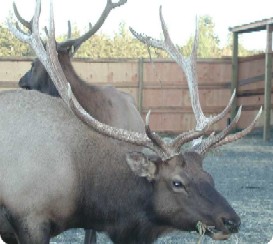 |
September - November: Rut! It's "hands off" time at the ranch
during rut. The bulls are at their most aggressive; bugling and posturing
in the attempt to establish dominance and thus, in their minds, have the
opportunity to mate with the cows. It doesn't seem to cross their minds
that the people have already selected which bull will mate with which cows.
They still think by filling the air with their eerie, yet intoxicatingly savage
calls they will somehow influence our decision on just who really should be
doing the breeding. About the most we do with the animals during rut is
toss them some alfalfa over the fence to keep them happy. Sounds dull, but
I have to tell you that there is NOTHING quite like walking down a 16' lane with
two 800+ pound bulls on either side of you bugling and glunking and chuckling as
you toss the hay to them. What an exhilarating experience!
|
